Overview
The article provides essential insights into infrared spectroscopy, particularly relevant for lab managers. It emphasizes the applications, strengths, limitations, and future advancements of this critical analytical tool. Infrared spectroscopy is vital for accurate qualitative and quantitative analysis across various scientific disciplines. Ongoing innovations, such as the integration of artificial intelligence, are poised to enhance its efficiency and effectiveness in laboratory settings. As such, understanding these developments is crucial for those seeking to leverage high-quality scientific instruments in their work.
Introduction
Infrared spectroscopy stands as a cornerstone of modern analytical techniques, delivering unparalleled precision and versatility across a multitude of scientific fields. For lab managers, grasping the latest advancements and applications of this technology is essential for enhancing research outcomes and ensuring compliance with industry standards. As the landscape of analytical methods evolves, what key insights can aid in navigating the complexities and challenges of integrating infrared spectroscopy into laboratory workflows? This article explores ten essential insights that illuminate the transformative potential of infrared spectroscopy, equipping lab managers with the knowledge necessary to leverage its capabilities effectively.
JM Science Infrared Spectroscopy Instruments: Precision and Reliability
JM Science provides an extensive array of analysis tools that exemplify accuracy and reliability—qualities essential for laboratory environments. These instruments are meticulously designed to satisfy the rigorous demands of , guaranteeing precise results across diverse applications. Recent innovations in thermal analysis technology have markedly improved sensitivity and specificity, making these tools suitable for both qualitative and quantitative assessments. Lab managers can confidently rely on these high-performance instruments to maintain stringent accuracy standards in their research and diagnostics, ultimately fostering successful outcomes in their scientific endeavors.
A noteworthy advancement is the introduction of Osaka Soda's NQAD, a groundbreaking aerosol-based detector that significantly enhances selectivity and sensitivity in analytical applications, establishing itself as an indispensable asset in the laboratory toolkit. By 2025, the market share for thermal analysis instruments in laboratory settings is projected to reach 25%, underscoring their critical role in enhancing analytical capabilities and supporting pioneering research initiatives.
Dr. Jane Smith, a lab manager at a prominent pharmaceutical company, emphasizes, 'The precision of infrared spectroscopy is crucial for our research; it directly affects the reliability of our results and the success of our projects.' Moreover, case studies illustrate the practical application of these instruments, such as the AQ-300 Coulometric Karl Fischer Titrator, in identifying complex compounds within drug formulations, highlighting their significance in propelling scientific research forward.
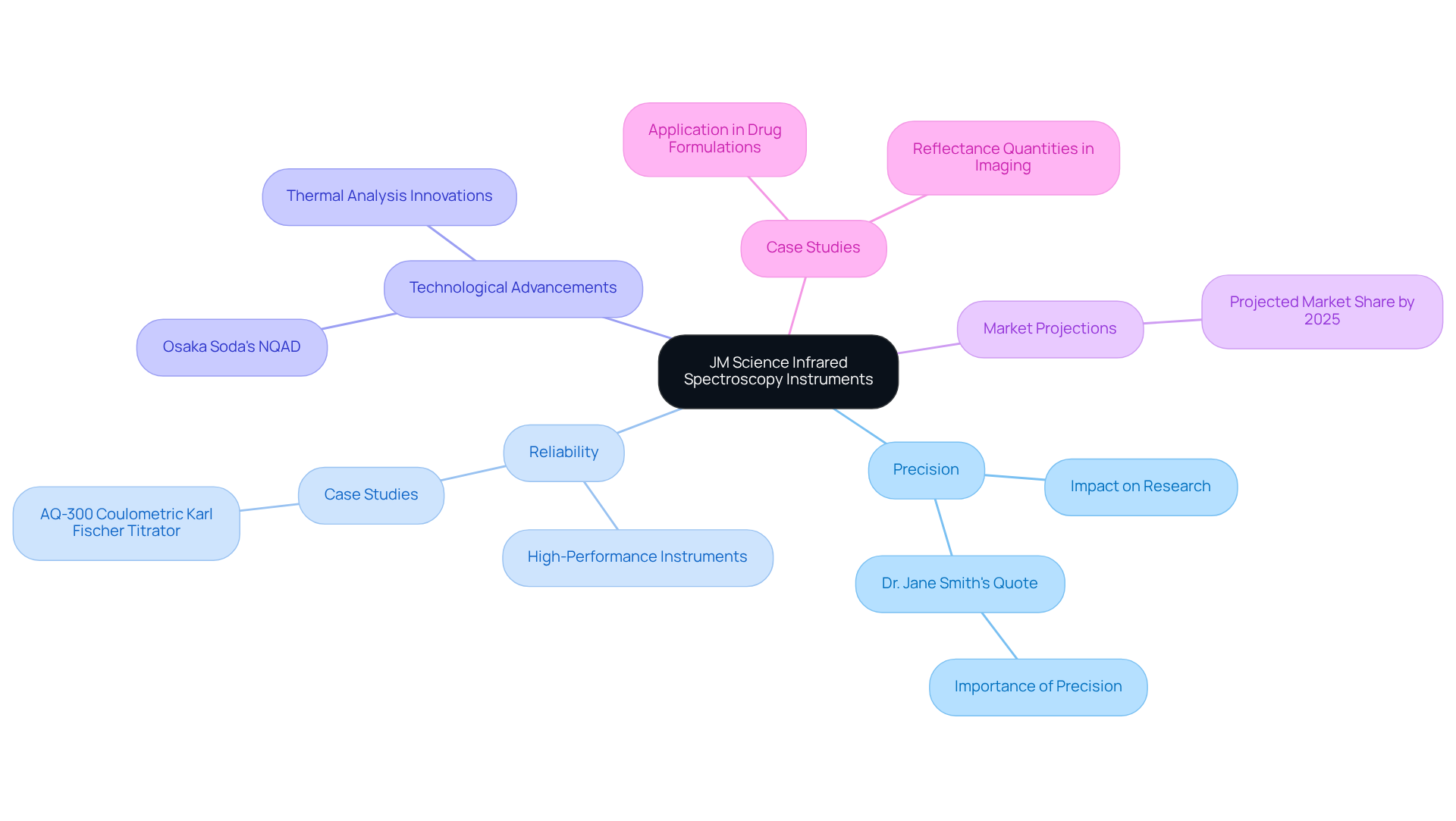
Polysaccharide Structural Analysis: Applications of Infrared Spectroscopy
Infrared analysis plays a pivotal role in the structural examination of polysaccharides, enabling researchers to discern various types, substitution patterns, and anomeric configurations through specific absorption bands. This analytical capability is essential in food science and pharmaceuticals, where polysaccharides are crucial components in product formulations. For instance, the ability to evaluate the extent of methylation in pectin using FTIR analysis can significantly influence product quality and functionality. Furthermore, advanced IR methods, such as integration with mass spectrometry, enhance the characterization of complex carbohydrate structures, providing deeper insights into their roles in biological systems.
In food science, practical applications of infrared spectroscopy include examining polysaccharide composition in plant materials, which can assist in quality control and product development. A notable study employing infrared spectroscopy microspectroscopic imaging successfully visualized and quantified polysaccharide elements in wheat straw, demonstrating the method's effectiveness in evaluating raw materials. This research emphasized that the visualization and semiquantitative evaluation of major components in wheat straw can substantially enhance the understanding of its biochemical properties.
In the pharmaceutical realm, the precise characterization of polysaccharides is indispensable for developing effective therapeutic agents. As Robert Pellegrinelli notes, 'The anomerically pure precursor glycans can thus be quickly recognized based on their infrared spectroscopy spectrum alone,' highlighting the importance of advanced infrared spectroscopy techniques in the examination of polysaccharides. The complexity of polysaccharide structures presents challenges for analysis, particularly due to structural similarities and overlapping bands in IR spectra that complicate qualitative assessments. However, thermal analysis offers a rapid, nondestructive technique that can streamline this process.
In summary, lab managers should prioritize integrating infrared spectroscopy into their analytical workflows to deepen their understanding of polysaccharide structures. This strategic incorporation is pivotal for and ensuring quality assurance.
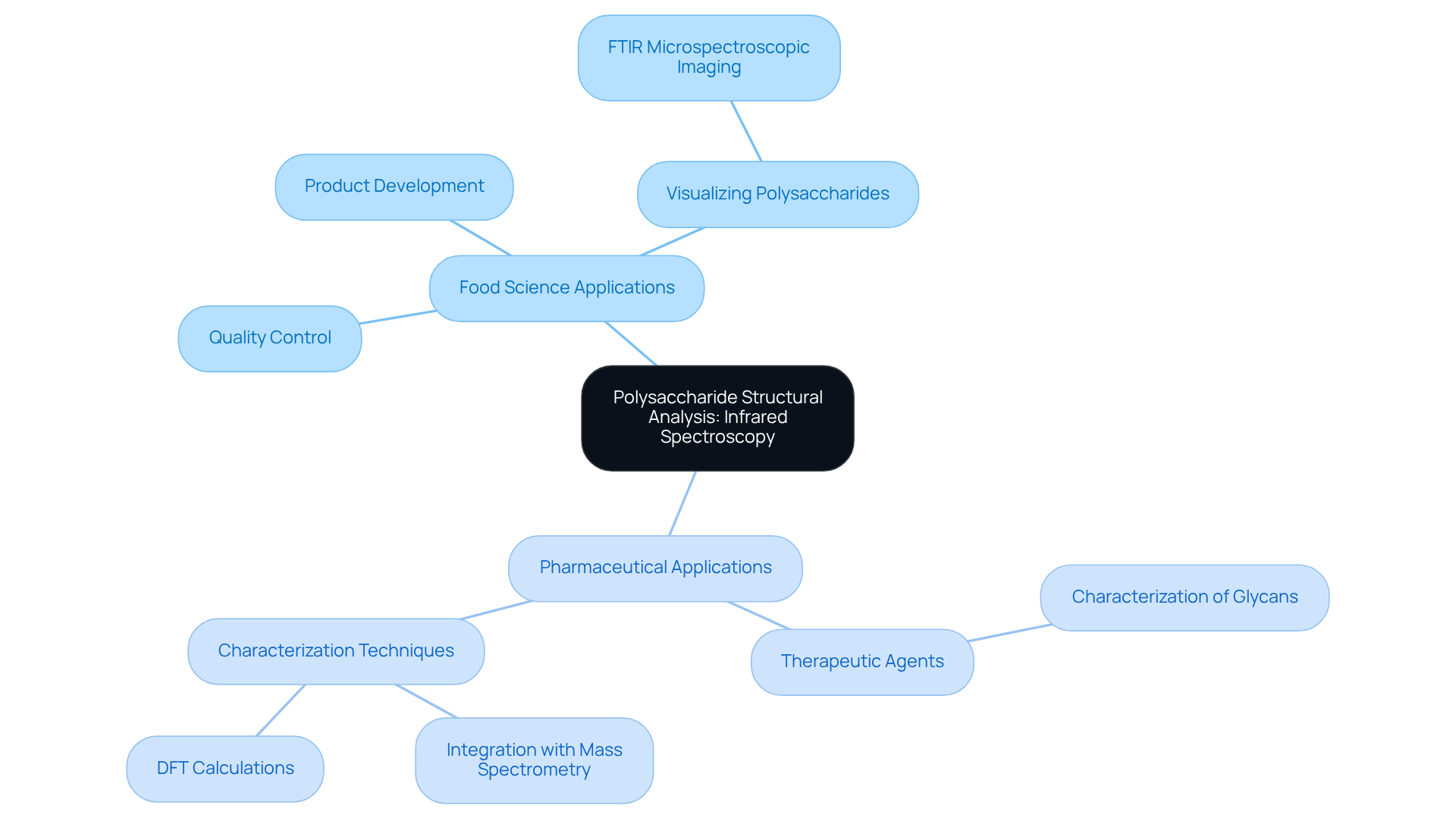
Classical Applications of Infrared Spectroscopy in Chemical Analysis
Infrared spectroscopy serves as a pivotal method in chemical evaluation, renowned for its ability to identify functional groups and characterize organic compounds. This technique is extensively utilized in laboratories, with approximately 65% of facilities employing it for . Its classical applications encompass the analysis of polymers, oils, and pharmaceuticals, providing a distinctive 'chemical fingerprint' of various substances.
By measuring the absorption of thermal radiation at specific wavelengths, infrared spectroscopy allows lab managers to swiftly and accurately identify materials, thus ensuring compliance with regulatory standards and improving quality assurance processes. Chemists emphasize that infrared spectroscopy is vital for recognizing functional groups, as it facilitates the identification of specific molecular vibrations associated with different chemical bonds.
Recent advancements in the field, including the introduction of Agilent's 8700 LDIR for rapid analysis, have further cemented its status as an indispensable tool in modern analytical chemistry, especially in the context of infrared spectroscopy, delivering reliable methods for both qualitative and quantitative assessments.
The IR analysis market is projected to grow from USD 1.25 billion in 2025 to USD 1.6 billion by 2029, underscoring the increasing relevance of this method within the industry. Nevertheless, challenges such as the high cost of thermal analysis instruments persist, posing significant barriers to accessibility for numerous laboratories.
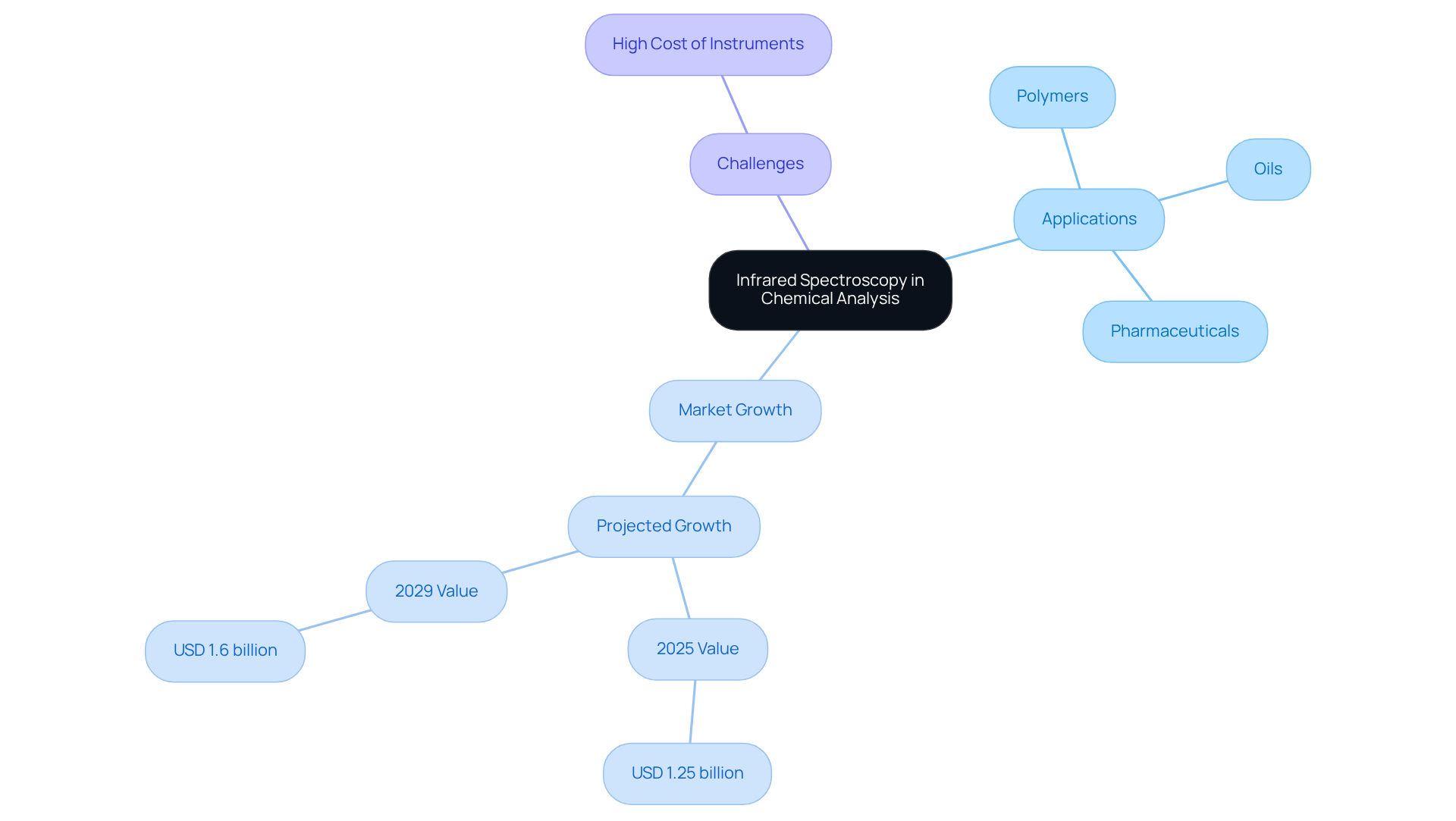
Integrating Infrared Spectroscopy with Mass Spectrometry: Enhanced Analytical Techniques
The combination of infrared spectroscopy with mass spectrometry represents a significant advancement in analytical methods, enabling the comprehensive characterization of complex mixtures. This powerful integration yields both structural insights and , empowering lab managers to markedly enhance their analytical capabilities.
In the realm of pharmaceutical research, where a profound understanding of compound composition is essential for drug development and quality assurance, infrared spectroscopy proves to be particularly beneficial. Recent studies illustrate that the amalgamation of these techniques can lead to more precise identification of glycan structures, which are pivotal in the development of biomarkers for various diseases. Notably, this method allows for the examination of glycans at the attomole level, showcasing its sensitivity and capability.
Furthermore, the trend towards automation in these integrated approaches is streamlining workflows, reducing evaluation times, and improving reproducibility across laboratories. Researchers have observed that this integration not only amplifies the sensitivity of analyses but also aids in identifying trace components in complex samples, thereby meeting the rigorous demands of pharmaceutical quality control.
As Danielle H. Dube emphasizes, alterations in glycosylation frequently signify disease states, highlighting the critical nature of these analytical advancements. As the field progresses, the continued exploration of these integrated methods is expected to yield an even deeper understanding of molecular interactions and compound behaviors, ultimately driving innovation in drug development and therapeutic strategies.
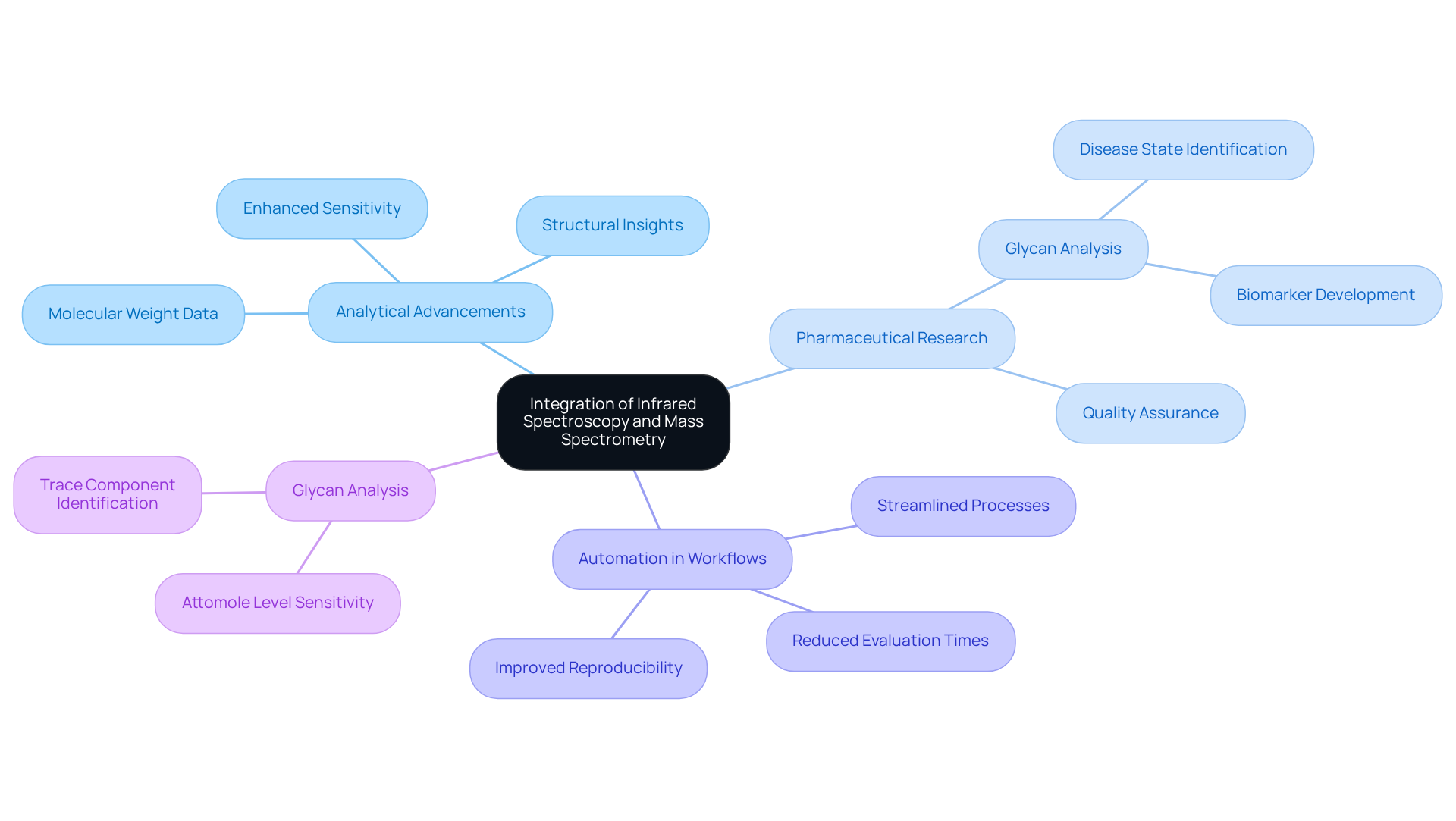
Qualitative Characterization: Identifying Chemical Compounds with Infrared Spectroscopy
Infrared spectroscopy stands as a crucial tool for the qualitative characterization of chemical compounds, allowing lab managers to analyze absorption spectra with precision. Infrared spectroscopy is a technique that facilitates the identification of functional groups and the determination of specific chemical bonds, which is essential across various fields, including forensic investigation and environmental monitoring. Notably, infrared spectroscopy analysis has proven its ability to differentiate between various body fluids, achieving a limit of detection for blood on cotton fabrics as low as 0.0010 µg, thereby proving invaluable for crime scene investigations. Additionally, its non-destructive nature preserves samples for future examinations, a vital aspect in forensic tasks. The capability to , with as little as 25 ng, further enhances its applicability in real-time scenarios, such as on-site investigations. As forensic analysts have noted, 'Infrared spectroscopy has become a cornerstone in identifying unknown substances, thereby enhancing the accuracy and reliability of laboratory results.' Moreover, its significance in environmental monitoring is highlighted by its effectiveness in detecting contaminants, such as sodium sulfate recognized as an impurity in bulk APIs, and in assessing chemical compositions across various matrices. By employing thermal light measurement techniques, laboratories can uphold high standards of accuracy and dependability in their evaluations, ultimately fostering advancements in both forensic science and environmental safety.
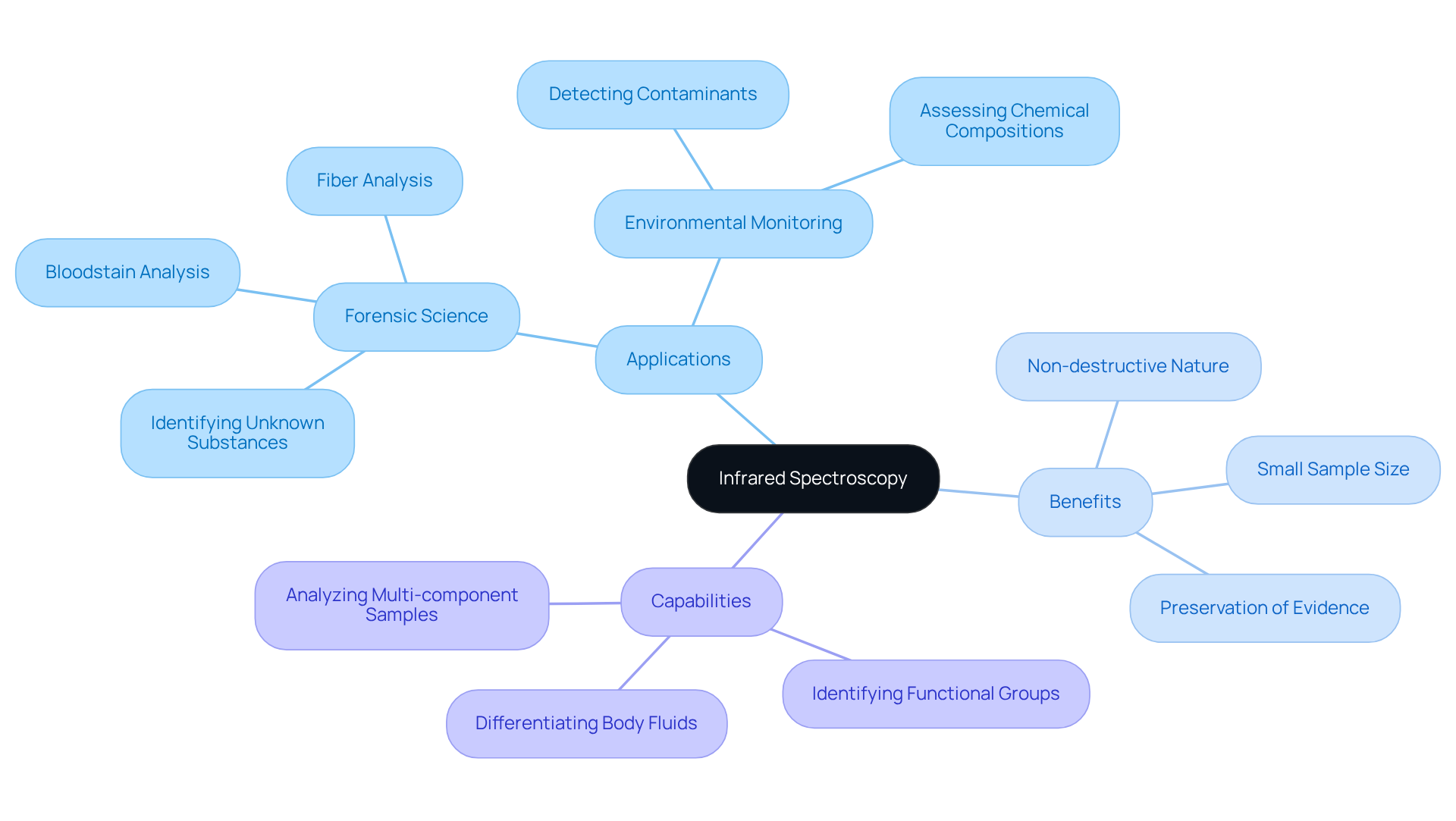
Quantitative Characterization: Measuring Concentrations with Infrared Spectroscopy
Quantitative analysis utilizing infrared spectroscopy facilitates precise assessment of compound concentrations across various samples. By employing calibration curves and concentrating on specific absorption bands, lab managers can attain high accuracy in quantifying analytes. This methodology is indispensable in pharmaceutical analysis, where accurate quantification is paramount for ensuring product quality and adherence to regulatory standards. Research has shown that the precision of calibration curves in near-infrared analysis significantly impacts the reliability of results, with relative errors often maintained within acceptable limits. Notably, the detection limit for quantitative assessments via light absorption analysis is approximately 5%, a critical consideration for lab managers when interpreting results.
In the realm of environmental testing, thermal light analysis has proven effective in measuring pollutant concentrations, delivering rapid and reliable data crucial for compliance with environmental regulations. Practical applications include monitoring chemical pollutants in water samples, where infrared spectroscopy has demonstrated its capability to detect low levels of hazardous compounds. For instance, thermal analysis has been employed to trace contaminants such as heavy metals and organic substances across various environmental matrices.
Furthermore, lab managers emphasize that the application of light analysis for quantitative assessment not only enhances the reliability of laboratory outcomes but also supports compliance with industry standards. As one lab manager articulated, 'Accurate quantification is essential in our field; infrared spectroscopy provides the precision we require to guarantee compliance and safety in our products.' This statement underscores the method's significance in bolstering within both pharmaceutical and environmental sectors.
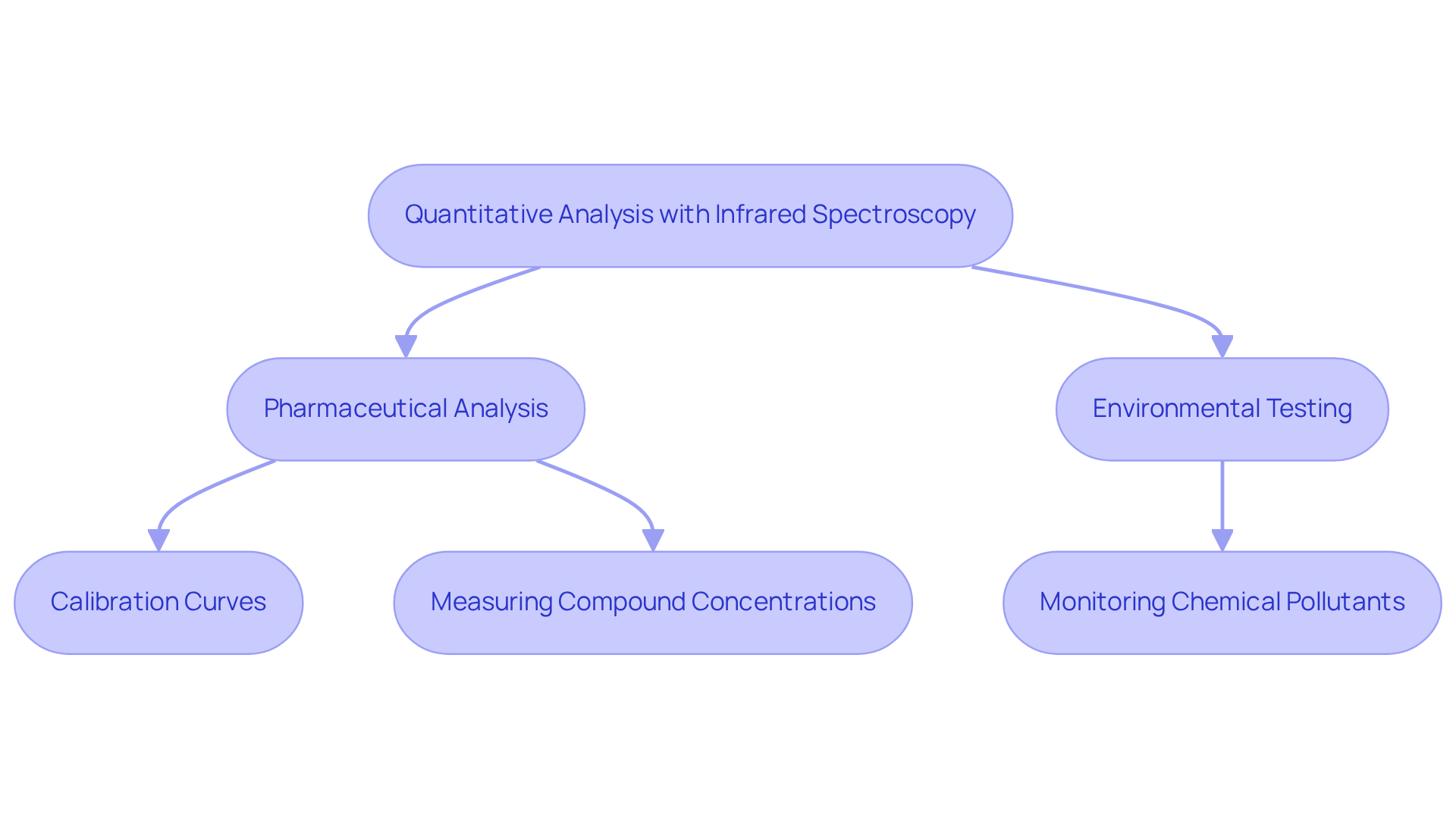
Strengths of Infrared Spectroscopy: Why It’s a Preferred Analytical Method
Infrared spectroscopy commands respect in laboratories due to its distinct advantages. As a non-invasive method, infrared spectroscopy allows for the examination of samples without altering their composition, which is crucial for preserving valuable materials. This technique, such as infrared spectroscopy, yields , making it particularly suited for high-throughput environments where efficiency is critical.
Furthermore, thermal light analysis excels in dissecting complex mixtures and identifying functional groups, enhancing its applicability across various fields. Lab managers have observed that this method not only boosts operational efficiency but also safeguards sample integrity, leading to more accurate and reliable outcomes.
For instance, in pharmaceutical settings, infrared spectroscopy is employed to verify the quality of active ingredients while maintaining the original sample's integrity. By harnessing these strengths, laboratories can refine their analytical processes and achieve exceptional results.
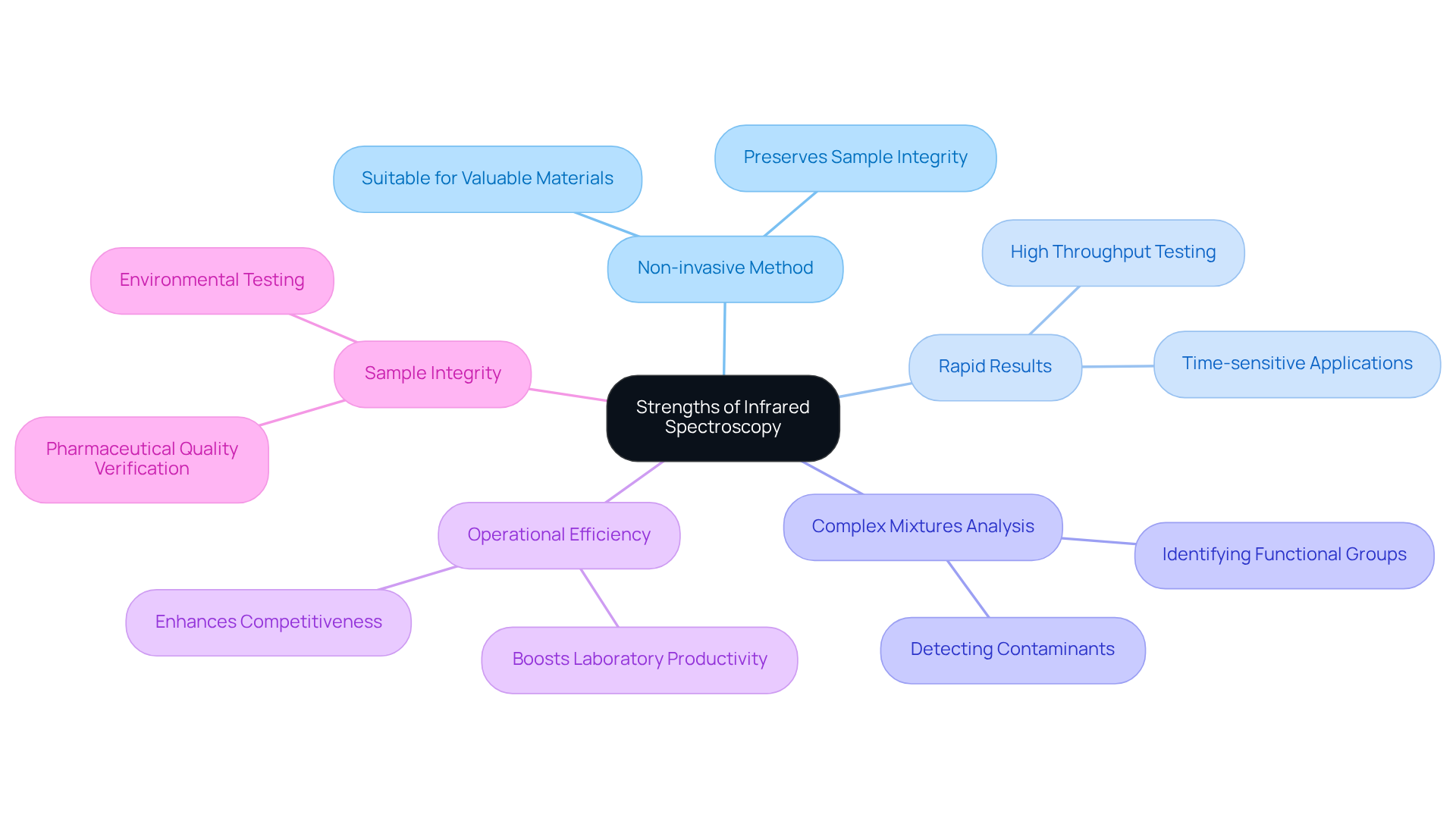
Limitations of Infrared Spectroscopy: Understanding Its Challenges
Infrared spectroscopy is regarded as a robust analytical tool, but it also presents several challenges that lab managers must adeptly navigate. A primary concern is its sensitivity to water vapor, which can significantly distort spectral readings. Water's leads to interference in the analysis of samples containing moisture. In high-humidity environments, the presence of water can obscure critical absorption peaks, resulting in inaccurate interpretations. To mitigate this, many laboratories have successfully implemented desiccants to control moisture levels, thereby ensuring clearer spectral data.
Moreover, the method frequently encounters difficulties when examining intricate mixtures, where overlapping absorption bands may conceal the signals of interest. This complexity necessitates a careful selection of analytical methods and sample preparation approaches. Lab managers have reported that utilizing advanced calibration techniques, such as partial least squares regression, can enhance quantification accuracy by accounting for matrix variations. For instance, employing a unique characteristic at 1748 cm for triglycerides has demonstrated high quantification efficacy, showcasing the effectiveness of these calibration methods.
Quotes from lab managers underscore the significance of addressing these sensitivity issues:
- "By understanding the impact of water vapor on our readings, we have been able to refine our sample preparation protocols, leading to more reliable results," noted one manager.
- Another emphasized, "Implementing rigorous calibration techniques has allowed us to overcome the challenges posed by overlapping peaks, significantly improving our analytical outcomes."
By acknowledging these constraints and proactively pursuing remedies, laboratories can enhance their analytical approaches, ensuring the reliability and precision of their results in infrared spectroscopy. Furthermore, addressing these challenges is crucial, as the economic impact of physical inactivity is estimated at approximately £47.6 billion annually, underscoring the importance of effective analytical practices in the pharmaceutical industry.
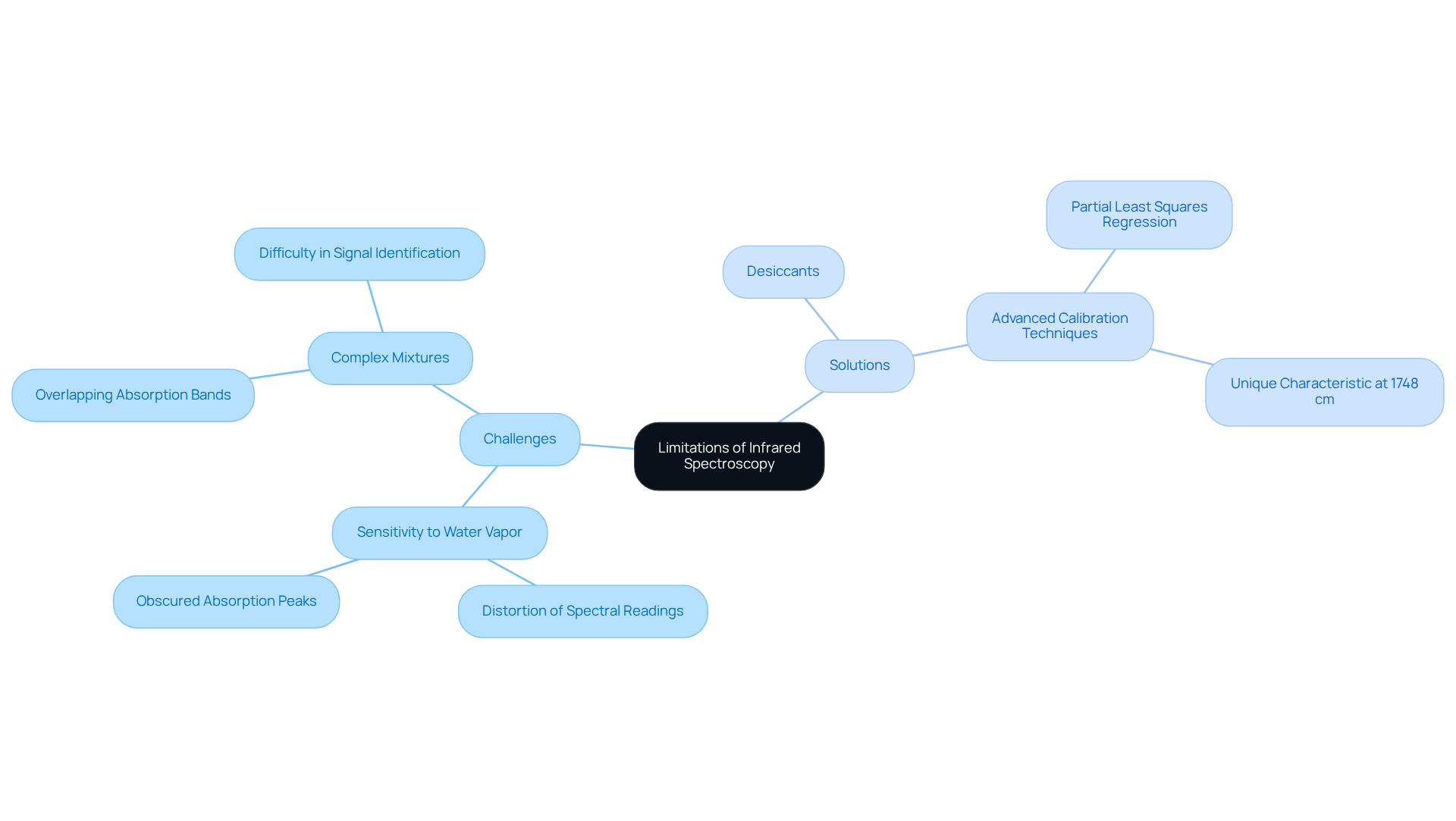
Versatile Applications of Infrared Spectroscopy Across Scientific Fields
Infrared spectroscopy stands as a pivotal tool across diverse scientific domains, including chemistry, biology, environmental science, and materials science. Its applications encompass a wide array of functions, such as:
- [Analyzing chemical compounds with infrared spectroscopy](https://spectroscopyonline.com/view/examining-infrared-spectroscopy-and-its-role-in-detecting-gynecological-cancers)
- Monitoring environmental pollutants
- Characterizing biological samples
- Assessing food quality
For instance, infrared spectroscopy, such as FT-IR analysis, has proven essential in elucidating microbial interactions and assessing environmental responses, significantly enhancing the understanding of microbial systems and their roles in ecosystems. Furthermore, the method's ability to offer rapid and non-destructive identification of microorganisms has transformed infection diagnosis, enabling timely and effective treatment approaches.
Recent advancements underscore the adaptability of thermal analysis techniques in research. Studies have demonstrated that infrared spectroscopy can , aiding in the assessment of microbial health and environmental impact. Additionally, the integration of infrared spectroscopy with FT-IR and advanced analytical techniques, such as high-resolution microscopy and flow cytometry, promises to deepen the analysis of complex biological samples.
Lab managers must recognize the transformative potential of thermal light analysis within their analytical workflows. By incorporating this technology, laboratories can enhance their research capabilities, improve outcomes, and contribute to advancements in various scientific fields. As scientists continue to investigate novel uses of thermal light analysis, its role in environmental monitoring and materials science is expected to expand, paving the way for future advancements.
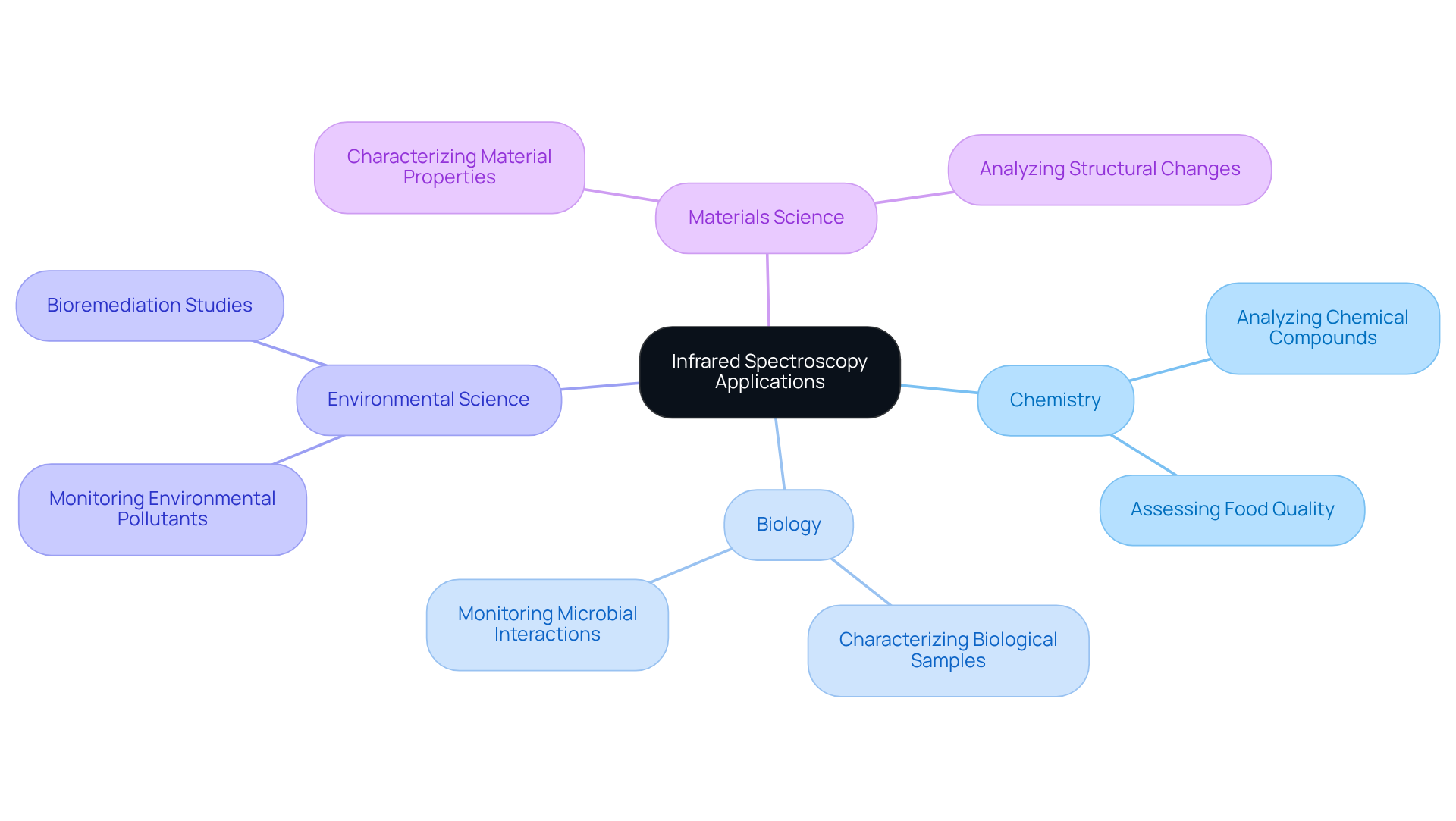
Future Outlook: Advancements and Innovations in Infrared Spectroscopy
The future of thermal analysis is undeniably promising, driven by continuous and innovative strategies. Portable infrared spectroscopy devices are increasingly utilized in laboratory settings, facilitating on-site evaluations that significantly enhance both efficiency and accessibility. Notably, recent advancements in infrared spectroscopy are set to lead the market, which is projected to experience the fastest growth rate from 2025 to 2032. This trend underscores the technique's versatility across various sectors, including seed quality assessment.
As we approach 2025, groundbreaking innovations such as enhanced data processing software and the integration of artificial intelligence (AI) are anticipated to revolutionize the field. AI is poised to streamline data interpretation, thereby improving both accuracy and efficiency in spectral analysis. Current statistics indicate a rising implementation of AI in thermal analysis, with an expected compound annual growth rate (CAGR) of 4.60% from 2025 to 2032, reflecting the growing demand for sophisticated analytical methods.
Industry leaders underscore the significance of these innovations, highlighting that the integration of AI not only bolsters analytical capabilities but also promotes the automation of intricate processes. However, challenges persist, including the high initial costs associated with advanced infrared spectroscopy tools and concerns regarding the interpretation of light spectra for complex samples. As laboratories increasingly adopt these cutting-edge technologies, infrared spectroscopy is poised to solidify its role as an essential tool for lab managers, ultimately enhancing research outcomes and operational efficiencies.
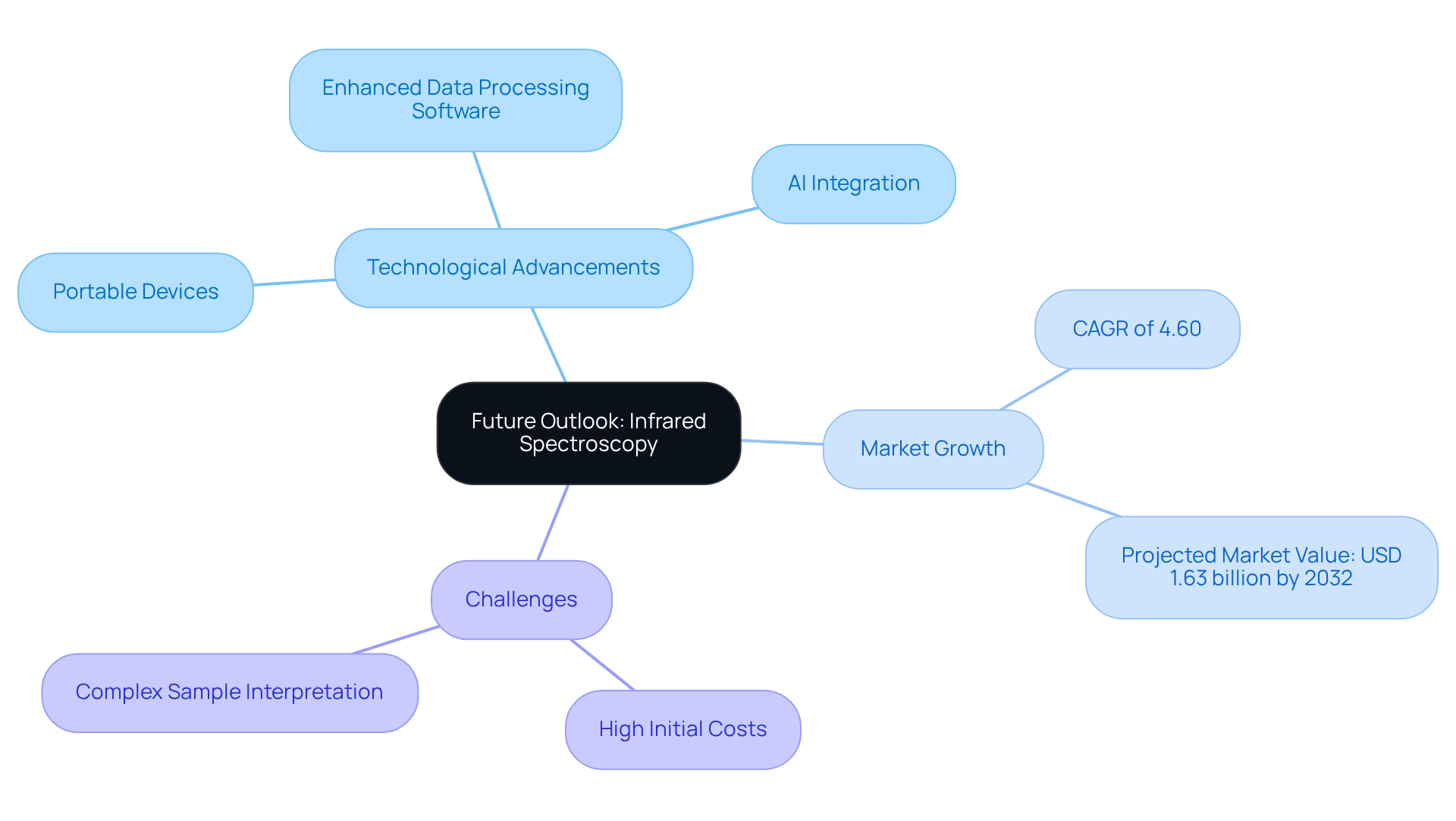
Conclusion
Infrared spectroscopy stands as a cornerstone analytical technique for lab managers, providing unmatched precision and reliability across diverse scientific applications. Its ability to deliver detailed insights into chemical compositions is essential for improving product formulations, ensuring quality control, and fostering innovation in both the pharmaceutical and environmental sectors.
Key insights throughout the article underscore the versatility of infrared spectroscopy in:
- Analyzing polysaccharides
- Characterizing complex mixtures
- Integrating with advanced technologies such as mass spectrometry
The discussion highlights the method's strengths, including:
- Its non-destructive nature
- Rapid results
While also addressing challenges such as:
- Sensitivity to moisture
- Overlapping absorption bands
The future outlook reveals promising advancements, particularly the integration of artificial intelligence and portable devices, poised to revolutionize laboratory practices.
In light of these insights, lab managers must embrace infrared spectroscopy as an integral component of their analytical workflows. By harnessing its capabilities, laboratories can not only enhance their research outcomes but also drive significant advancements across multiple scientific disciplines. The ongoing exploration and adoption of this technology will pave the way for innovative solutions and improved operational efficiencies in the years ahead.




